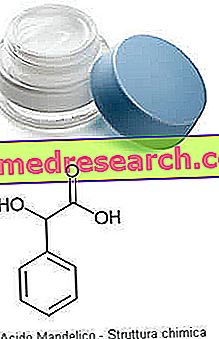What is Mandelic Acid?
They speak of him as a faithful ally of female beauty: mandelic acid.

Mandelic acid has set foot in cosmetics for about fifty years, immediately attracting the attention of many researchers; so much so that, still today, it constitutes a prestigious cosmetic ingredient used to lighten and exfoliate the skin.
Curiosity
Mandelic acid has been dubbed "amygdalic acid" in memory of the unique way it was discovered: the substance was randomly isolated during the heating of a bitter almond extract (containing amygdalin) diluted in hydrochloric acid. The name "mandelic" derives from the word " mandel " which means almond in German.
Chemical analysis
The molecular formula of mandelic acid is C 6 H 5 CH (OH) CO 2 H: it is a crystalline solid soluble in water, ether and isopropyl alcohol. The substance comes in the form of large transparent rhomboid-shaped crystals; moreover, it is available in crystalline and white powder which, subjected to prolonged solar or artificial UV irradiation, darkens and decomposes easily.
Mandelic acid is odorless or slightly aromatic. The taste has a very pungent salt taste. In natural form, mandelic acid is levorotatory, while in synthetic form it is a raceme.
Applications
Mandelic acid has been the subject of numerous researches: its use does not stop only with cosmetics. Suffice it to say that, in the past, the substance was widely used in the treatment of urinary tract infections, thanks to its antibacterial properties. Some countries used the same mandelic acid for its alleged antibiotic properties.
Only towards the seventies of the twentieth century, mandelic acid caught the attention of cosmetologists for the creation of creams or other depigmenting and exfoliating cosmetic products.
In cosmetics, mandelic acid is now used for the preparation of creams, gels or masks to be applied to the skin. Again, this molecule is the leading cosmetic ingredient in numerous chemical peels with exfoliating and depigmenting action .
Cosmetic and dermatological uses

- Treatment of vulgar acne (in the form of peeling): indication of the mandelic acid par excellence (thanks to its antibacterial properties, capable of reducing the proliferation of Propionibacterium acnes );
- Treatment of blackheads (blackheads);
- Treatment of skin discoloration (eg spots on the skin) related to photo-aging;
- Treatment of melasma, chloasma, freckles;
- Treatment to improve the signs and symptoms related to pustular / papular acne;
- Skin re-compacting treatment;
- Detoxifying skin treatment (in the form of a face mask);
- Anti-wrinkle treatment (remedy against superficial wrinkles);
- Alternative treatment against rosacea (visibly improves the signs and symptoms of the disorder);
- Pre and post-laser treatment, as it soothes skin irritation.
Finally, mandelic acid is used in cosmetics to deeply moisturize the skin. In these cases, however, it is generally in association with other substances, such as hyaluronic acid or allantoin.
Did you know that ...
Starting from mandelic acid derivatives it is possible to make some drugs. For example, the active ingredients "ciclandelate" (spasmolytic used to treat peripheral vasculopathies) and "homatropin" (an anticholinergic medicine used to treat uveitis) are esters of mandelic acid.
Advantages
Mandelic acid is distinguished by the extraordinary exfoliating properties and the advantages it offers: this substance, in fact, is very appreciated for its (almost total) absence of side effects and contraindications on the skin.
Unlike creams with glycolic acid and products prepared with other alpha-hydroxy acids (chemical exfoliants), cosmetics based on mandelic acid are not photosensitizers ; consequently, they can also be applied a few hours before sun exposure or a tanning session.
Again, compared with glycolic acid, mandelic acid - once applied to the skin - produces less erythema, often even imperceptible. In fact, in most cases, immediately after laying the product on healthy skin, the patient does not feel burning, itching or pain.
Practical advice
After a chemical peel with mandelic acid it is advisable to apply a generous amount of emollient and nourishing cream to the skin. Even the natural creams formulated with plant extracts with a soothing action (eg calendula extract) prove to be an excellent help for the skin.
Side effects
Although mandelic acid has a more delicate exfoliating action than other alpha-hydroxy acids, it is nevertheless able to cause undesirable effects in sensitive individuals.
Fortunately, these side effects are normally mild and consist of redness, burning and mild irritation. Generally, these phenomena tend to resolve by suspending the use of the product containing mandelic acid.
Mandelic Acid Creams
In cosmetic preparations, mandelic acid is often combined with other substances with a lightening action (to enhance the final effect), moisturizing, antioxidant and nourishing. We see below the most common cosmetic ingredients that support the pseudo-therapeutic action of mandelic acid:
- Glycolic acid creams + mandelic acid : both molecules have the same exfoliating and depigmenting action. In similar situations, the final effect is enhanced by the synergistic action of the two substances. Warning: the presence of glycolic acid requires abstention from the sun for at least 24-48 hours before and after applying the cosmetic to the skin.
- Multivitamin cream + mandelic acid : the presence of vitamin A, C and E acts in synergy with mandelic acid, enhancing the anti-radical (antioxidant) effect, which is extremely important for the treatment of mature skin.
- Hyaluronic acid creams + mandelic acid : the combination of these two products ensures an excellent moisturizing and anti-aging effect (given by hyalonic acid) combined with a powerful lightening and exfoliating action (of mandelic acid).
- Azelaic acid creams + mandelic acid : strengthening of bacteriostatic and bactericidal activity against bacteria involved in the appearance of vulgar acne.



